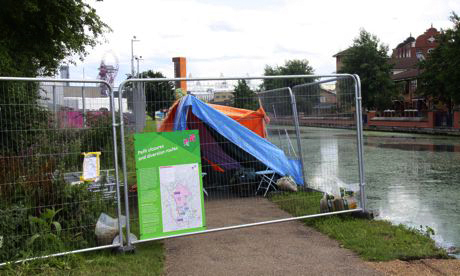London legacy: security and towpath protests

Section of River Lea navigation canal next to Olympic Park closed off and guarded by soldiers in tent. Photograph: Dave Hill
It’s not as dramatic as having anti-aircraft missiles planted on your roof, but the closure of a popular walking and cycling route that borders the western edge of the Olympic Park has prompted the same sort of resentment among some local people. I’m feeling just a touch of it myself.
On Sunday, personal experience confirmed that my regular run from my home in Clapton to the Olympic stadium and back will not be possible again until 10 September for reasons of Games security. The towpath on the eastern bank of the River Lea navigation canal was fenced off just past Hackney Marshes, at the point where the A12 flies over it, all the way to Bow to the south.
A small group of demonstrators had gathered in protest at the Marshes end, distinguished by bicycles, waterproof garments and small children. Police officers stood in attendance. Behind the wire I made out a figure in military fatigues next to a little tent. Beyond him, the Olympic press centre stood behind the perimeter fence, awaiting colonisation by journalists. The Open Our Towpath campaign has blogged about its demo and you can see more photos of the scene here.
Yes, it was sort of chilling – a small but deadly earnest military presence appearing as if from nowhere to colonise and deprive. Some might find it reassuring but, either way, it’s a stark reminder of terrorism anxiety and its habit of curtailing valued freedoms. On these occasions I try to put myself inside the shoes of those who’d get the blame should some atrocity occur – hands up who forgot to block the towpath – yet they also underline my determined view that the whole Games palaver had better be worth all the trouble in the end.
Ruth-Anna Macqueen, a junior doctor who co-organised Sunday’s protest, recognises the need for precautionary measures, but wouldn’t mind just a clue or two from the authorities about why this particular section of the park perimeter is being placed out of bounds. “You can walk, drive or even live close to other parts of the fence,” she says, and complains that Locog simply repeats a mantra about unspecified security reasons.
She also thinks the move was poorly planned. Ruth-Anna cycles daily from her home in Clapton (all the best people…) to work at Newham hospital, but having already lost access to the Greenway, which linked east Hackney to Stratford, she’s not smitten with the official alternative route. Neither was the London Cycling Campaign (LCC), when it got wind of the arrangement back in March:
Whereas the two mile towpath route is smooth, direct and traffic free the 3.2 mile diversion has over 40 turnings including a left and right turn on Bow road and the horrendous Hackney Wick motorway junction.
The by-pass includes one section of estate roads where cyclists will have to dismount and push their cycles. Without very careful signage visitors are likely to be easily lost and confused.
LCC added that in 2009 Games transport organisers were anticipating the towpath being a route to be promoted for cyclists and pedestrians during the Games. A new “floating towpath” and bridge across the river was constructed at the Bow end, but that too has now been placed out of bounds.
Ruth-Anna contends that preparations might have been better had Games authorities, “Seen how many people use the towpath at 8.00 in the morning.” She’s not alone in remarking on the incongruity of the greatest sporting show in the world making it harder for people to run, walk and cycle past that show’s main location (or indeed many other parts of London) for several weeks. A letter has been written to Boris Johnson, the “cycling mayor,” setting out the case against the closure and seeking his support.
I don’t think it will be forthcoming, but perhaps the campaign will concentrate the mayoral mind on ensuring that first-class walking and cycling facilities are truly part of the post-Games transport legacy. Further demonstrations are being planned.
As my runner’s knees know, the pre-Games period has seen big improvements to the Lea towpath surface, not just near the Olympic Park but also by Lea Bridge to the north and still further to the stretch that flanks the Arriva bus garage between the Stonebridge and Picketts locks.
Continued, sound investment will pay dividends in the long term and may make 2012’s summer of sport towpath closure easier for irked local residents to forgive. The same principle might be usefully applied to the legacy promise as a whole.
guardian.co.uk © Guardian News & Media Limited 2010
Published via the Guardian News Feed plugin for WordPress.
